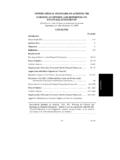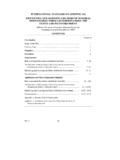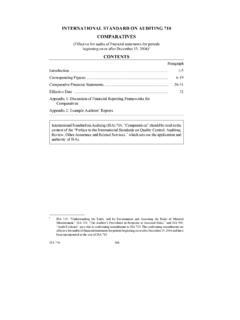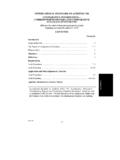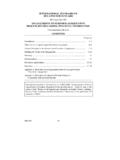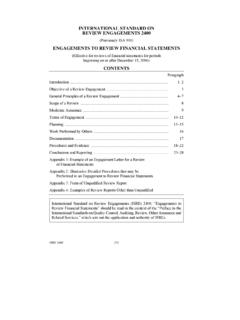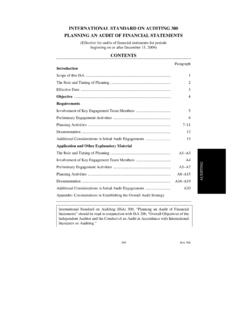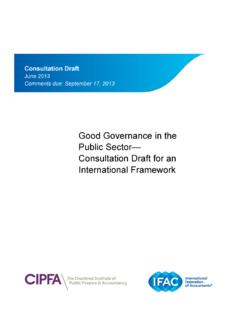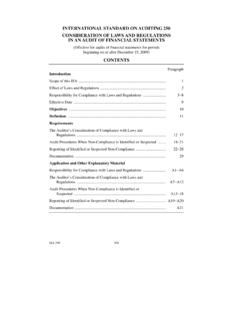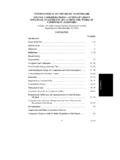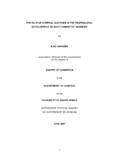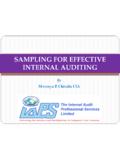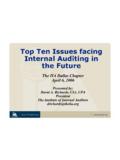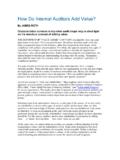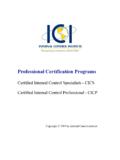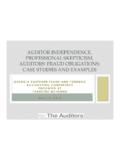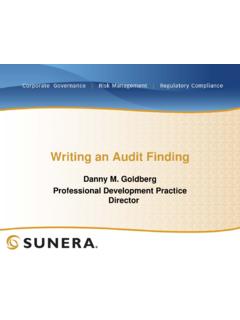Transcription of INTERNATIONAL STANDARD ON AUDITING 610 USING …
1 ISA 610 625 AUDITING INTERNATIONAL STANDARD ON AUDITING 610 USING THE work OF internal auditors (Effective for audits of financial statements for periods beginning on or after December 15, 2009) CONTENTS Paragraph Introduction Scope of this ISA .. 1 2 Relationship between the internal Audit Function and the External Auditor .. 3 4 Effective Date .. 5 Objectives .. 6 Definitions .. 7 Requirements Determining Whether and to What Extent to Use the work of the internal auditors .. 8 10 USING Specific work of the internal auditors .. 11 12 Documentation .. 13 Application and Other Explanatory Material Scope of this ISA .. A1 A2 Objectives of the internal Audit Function .. A3 Determining Whether and to What Extent to Use the work of the internal auditors .. A4 A5 USING Specific work of the internal auditors .
2 A6 INTERNATIONAL STANDARD on AUDITING (ISA) 610, USING the work of internal auditors should be read in conjunction with ISA 200, Overall Objectives of the Independent Auditor and the Conduct of an Audit in Accordance with INTERNATIONAL standards on AUDITING . USING THE work OF internal auditors ISA 610 626 Introduction Scope of this ISA 1. This INTERNATIONAL STANDARD on AUDITING (ISA) deals with the external auditor s responsibilities relating to the work of internal auditors when the external auditor has determined, in accordance with ISA 315,1 that the internal audit function is likely to be relevant to the audit. (Ref: Para. A1 A2) 2. This ISA does not deal with instances when individual internal auditors provide direct assistance to the external auditor in carrying out audit procedures. Relationship between the internal Audit Function and the External Auditor 3.
3 The objectives of the internal audit function are determined by management and, where applicable, those charged with governance. While the objectives of the internal audit function and the external auditor are different, some of the ways in which the internal audit function and the external auditor achieve their respective objectives may be similar. (Ref: Para. A3) 4. Irrespective of the degree of autonomy and objectivity of the internal audit function, such function is not independent of the entity as is required of the external auditor when expressing an opinion on financial statements. The external auditor has sole responsibility for the audit opinion expressed, and that responsibility is not reduced by the external auditor s use of the work of the internal auditors . Effective Date 5. This ISA is effective for audits of financial statements for periods beginning on or after December 15, 2009.
4 Objectives 6. The objectives of the external auditor, where the entity has an internal audit function that the external auditor has determined is likely to be relevant to the audit, are: (a) To determine whether, and to what extent, to use specific work of the internal auditors ; and (b) If USING the specific work of the internal auditors , to determine whether that work is adequate for the purposes of the audit. 1 ISA 315, Identifying and Assessing the Risks of Material Misstatement through Understanding the Entity and Its Environment, paragraph 23. USING THE work OF internal auditors ISA 610 627 AUDITING Definitions 7. For purposes of the ISAs, the following terms have the meanings attributed below: (a) internal audit function An appraisal activity established or provided as a service to the entity.
5 Its functions include, amongst other things, examining, evaluating and monitoring the adequacy and effectiveness of internal control. (b) internal auditors Those individuals who perform the activities of the internal audit function. internal auditors may belong to an internal audit department or equivalent function. Requirements Determining Whether and to What Extent to Use the work of the internal auditors 8. The external auditor shall determine: (a) Whether the work of the internal auditors is likely to be adequate for purposes of the audit; and (b) If so, the planned effect of the work of the internal auditors on the nature, timing or extent of the external auditor s procedures. 9. In determining whether the work of the internal auditors is likely to be adequate for purposes of the audit, the external auditor shall evaluate: (a) The objectivity of the internal audit function; (b) The technical competence of the internal auditors ; (c) Whether the work of the internal auditors is likely to be carried out with due professional care; and (d) Whether there is likely to be effective communication between the internal auditors and the external auditor.
6 (Ref: Para. A4) 10. In determining the planned effect of the work of the internal auditors on the nature, timing or extent of the external auditor s procedures, the external auditor shall consider: (a) The nature and scope of specific work performed, or to be performed, by the internal auditors ; (b) The assessed risks of material misstatement at the assertion level for particular classes of transactions, account balances, and disclosures; and (c) The degree of subjectivity involved in the evaluation of the audit evidence gathered by the internal auditors in support of the relevant assertions. (Ref: Para. A5) USING THE work OF internal auditors ISA 610 628 USING Specific work of the internal auditors 11. In order for the external auditor to use specific work of the internal auditors , the external auditor shall evaluate and perform audit procedures on that work to determine its adequacy for the external auditor s purposes.
7 (Ref: Para. A6) 12. To determine the adequacy of specific work performed by the internal auditors for the external auditor s purposes, the external auditor shall evaluate whether: (a) The work was performed by internal auditors having adequate technical training and proficiency; (b) The work was properly supervised, reviewed and documented; (c) Adequate audit evidence has been obtained to enable the internal auditors to draw reasonable conclusions; (d) Conclusions reached are appropriate in the circumstances and any reports prepared by the internal auditors are consistent with the results of the work performed; and (e) Any exceptions or unusual matters disclosed by the internal auditors are properly resolved. Documentation 13. If the external auditor uses specific work of the internal auditors , the external auditor shall include in the audit documentation the conclusions reached regarding the evaluation of the adequacy of the work of the internal auditors , and the audit procedures performed by the external auditor on that work , in accordance with paragraph ** Application and Other Explanatory Material Scope of this ISA (Ref: Para.)
8 1) A1. As described in ISA 315,3 the entity s internal audit function is likely to be relevant to the audit if the nature of the internal audit function s responsibilities and activities are related to the entity s financial reporting, and the auditor expects to use the work of the internal auditors to modify the nature or timing, or reduce the extent, of audit procedures to be performed. A2. Carrying out procedures in accordance with this ISA may cause the external auditor to re-evaluate the external auditor s assessment of the risks of material misstatement. Consequently, this may affect the external auditor s 2 ISA 230, Audit Documentation, paragraphs 8 11, and A6. 3 ISA 315, paragraph A101. USING THE work OF internal auditors ISA 610 629 AUDITING determination of the relevance of the internal audit function to the audit.
9 Similarly, the external auditor may decide not to otherwise use the work of the internal auditors to affect the nature, timing or extent of the external auditor s procedures. In such circumstances, the external auditor s further application of this ISA may not be necessary. Objectives of the internal Audit Function (Ref: Para. 3) A3. The objectives of internal audit functions vary widely and depend on the size and structure of the entity and the requirements of management and, where applicable, those charged with governance. The activities of the internal audit function may include one or more of the following: Monitoring of internal control. The internal audit function may be assigned specific responsibility for reviewing controls, monitoring their operation and recommending improvements thereto. Examination of financial and operating information.
10 The internal audit function may be assigned to review the means used to identify, measure, classify and report financial and operating information, and to make specific inquiry into individual items, including detailed testing of transactions, balances and procedures. Review of operating activities. The internal audit function may be assigned to review the economy, efficiency and effectiveness of operating activities, including non-financial activities of an entity. Review of compliance with laws and regulations. The internal audit function may be assigned to review compliance with laws, regulations and other external requirements, and with management policies and directives and other internal requirements. Risk management. The internal audit function may assist the organization by identifying and evaluating significant exposures to risk and contributing to the improvement of risk management and control systems.
